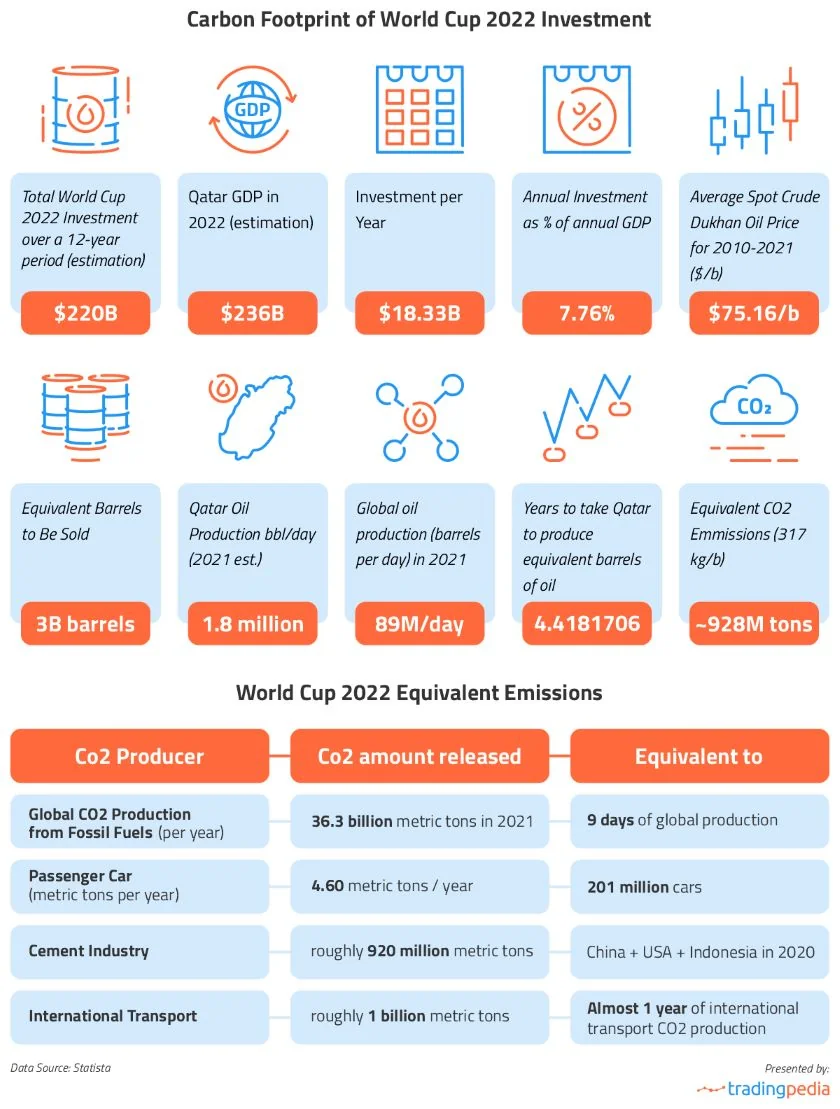DREAMS OF A CARBON-NEUTRAL WORLD CUP?
December 10, 2022 | Expert Insights

As the 'Greatest Show on Earth' heads towards its ecstatically awaited final, the controversies surrounding it never end. Twelve years ago, when the tiny oil-rich desert kingdom of Qatar surprisingly won the right to host the 2022 FIFA World Cup, beating the U.S. by a margin of 14 votes to 8, it has ever since been marred by controversies.
There have been accusations of corruption in the selection process and human rights violations in the mad construction race to get the desert kingdom ready for the games in a brief span of a decade. As per a widely distributed report by the Guardian newspaper, nearly 6500 migrant workers employed in the construction industry from India, Pakistan, Nepal, Bangladesh and Sri Lanka allegedly died due to negligence, callousness and cost-cutting that ignored safety.
Now the issue in focus is the environment; the quantum of greenhouse gases that may have been emitted during the month-long games with millions heading to Qatar, a country with air-conditioned stadiums, subways, bus stops, trains, and taxis. Apparently, this small and super-rich emirate has the world's highest carbon emissions per capita – a country whose primary sources of income are oil production and sale.
During the build-up to the games, FIFA and host Qatar had assured the world that it would be "a first-ever carbon neutral World Cup", as measures had been taken to limit carbon output and offset greenhouse emissions by purchasing carbon credits.
As per the Guardian, FIFA now admits that the tournament's carbon footprint will be bigger than any of its predecessors, and experts believe emissions have been underestimated, calling into question the claim of carbon neutrality.
Background
The FIFA World Cup is not only one of the biggest sporting features in the world but also a significant cultural, social, and economic event. Typically, host countries make substantial investments to boost tourism and long-term economic growth, along with reasons of national prestige. As a small country with only one major city, Doha, and a population of slightly more than 2.7 million people, Qatar lacked the infrastructure to host a FIFA World Cup a decade ago.
Nevertheless, Qatar boldly committed to hosting the first carbon-neutral World Cup for the 2022 tournament. In a 56-page sustainability strategy, FIFA and Qatar revealed their plan for carrying out that promise. This plan included strategies to track greenhouse gas emissions, reduce waste and air pollution, and offset emissions.
It took a lot of work to construct the tournament's infrastructure. The metro system, however, was built before the event, and organisers said it would outlive the World Cup and minimise emissions from travel between games. According to FIFA, stadiums were built with sustainability in mind, and some will be torn down or repurposed after the tournament, like ‘Stadium 974’ built entirely of 974 shipping containers!
Experts claim otherwise. As per a report in the German Deutsche Welle (DW) news agency, Carbon Market Watch, a non-profit environmental group's study has shown that the event will emit nearly 3.6 million tons of CO2, roughly equivalent to the annual output of the Democratic Republic of Congo or Armenia!

Analysis
While the event's overall predicted environmental impact has probably been overestimated, the carbon credits that could offset the emissions run the danger of having poor environmental integrity.
Another larger issue that is escaping notice is that the nation's massive $220 billion investment made over the previous ten years in stadia, highways, hotels, highways, metro etc., were all paid in fossil fuel.
Given that Qatari crude sells for an average price of $75.16 per barrel, the nation has had to sell close to 3 billion barrels of oil to cover the cost of this extravagance. Overall, Qatar will produce enough oil to last for four years. When burned, it will contribute 928 million tonnes of carbon dioxide to the atmosphere, and carbon credits won't be able to change this.
It is projected that each of the last three World Cups produced 2.2 to 2.8 million tonnes of carbon dioxide equivalent. The competition this year represents a breakthrough. According to one estimate, the present event in Qatar might produce up to 10 million tonnes of CO2e.
The environmental impact is mainly in two key areas. The first is transport. Fan flights from every big international sporting event are the main contributors to emissions because flying is such a carbon-intensive mode of transportation. The second area is the massive energy and material footprint of developing new stadiums, transportation systems, and hotels to house tens of thousands of spectators. These two verticals overlap since they are primarily concerned with accommodating and moving fans rather than football players and their entourage.
Certain emission reduction measures put in place could mislead spectators and citizens worldwide into thinking that the organisers are doing more to combat climate change than they actually are. These measures are unlikely to have a significant and long-lasting impact on the greenhouse gases concentration in the atmosphere. This might cause future and present complacency over the competition with a substantial carbon footprint, which would continue to harm the planet.
In a desert country with hardly any water to spare, the games would require an additional 10,000 litres per day for each football pitch! Since Qatar uses massive desalination plants to convert seawater into fresh potable water, releasing hot, toxic brine into the seas would not be good for marine life.
However, Stadium 974, also known as Stadium Ras Abu Aboud, has been lauded by the organisers as the centrepiece of the sustainability strategy for the 2022 World Cup. This is the first temporary stadium in World Cup history, and it has the provision of removing a portion of the seats to lower its capacity. World Cup hosts like Russia have previously utilised such demountable seats to reduce stadium capacity after the competition. However, Qatar will be the first nation to have a fully demountable stadium that will be repurposed for other athletic events.
This has a plethora of benefits. First, if stadiums from past tournaments can be relocated and used again, it might result in fewer stadiums being constructed in the future. Second, it allows stadiums to be built in more accessible, central places that will alleviate traffic without requiring them to remain there for years or decades after the event has ended. Third, sharing the initial expenses of stadium construction among several nations that will host the event in various years might make hosting mega-events more affordable for developing countries.
Assessment
- FIFA should make public a detailed emissions reduction strategy and a thorough accounting of its direct and indirect greenhouse gas emissions. The organisation that oversees world football must provide a clear and quantitative plan to support its commitment to achieving climate neutrality by 2040.
- FIFA needs to reconsider how the World Cup is hosted. Alternatives should be created and presented for expert and public opinion. One alternative could be spreading the event over a larger geographical space to reduce the environmental impact.








Comments